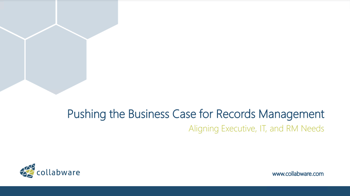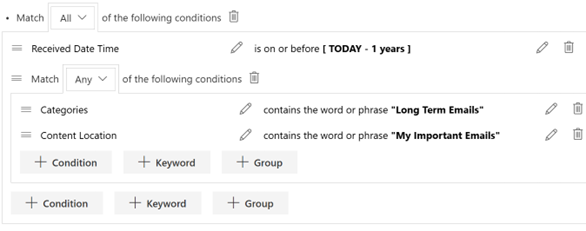Aligning Executive, Information Technology and Records Management Needs
 Image shows team around a conference table with their hands together. Photo by Thirdman on Pexels.
Image shows team around a conference table with their hands together. Photo by Thirdman on Pexels.
Records management (RM) should be a critical part of any organization because, when done properly, its benefits are company-wide. You know it, we at Collabware know it. But maybe you need support to get the rest of your organization to understand that RM is worth the initial time, effort and investment.
Our CEO, Graham Sibley, has heard records managers' pain points before and delivered a presentation specifically on how to push the business case for records management to align across departments.
The full presentation slides are available for free download below, but we've created this article as both a teaser and guide for supporting your initiative to give records management a seat at the decision-making table. We'll cover the important questions, including:
- The value of RM (if you know, you know)
- Align the departments by asking....
The value of records management (IFYKYK)
We likely don't have to tell you that managing your properly managing your records not only keeps your client and business-critical data secure, protects your organization from hefty fines (such as the millions fined to financial institutions who were not compliant to SEC17a-4) and allows your whole team to be more productive to having your records well organized and thus, easily searchable.
That can require additional time, support and investment in proper tools.
But maybe you're telling this to your colleagues in other departments and receiving comments such as...
'"Is our risk really that high? Don’t you already have this covered? We really need to focus on things that will help us grow." - Executive team member
"I don’t want another system to manage, just use what Microsoft 365 offers. What do you mean I need to staff for that? Isn’t that your job?" - IT
"I don’t have time to spend adding metadata for every file. Just give me a place to put the files and you take care of the rest." - Pretty much everyone else
Sound familiar? Graham encourages asking the following questions to overcome being overlooked:
Who is involved, and what is their mission?
Often times, other department members may not see the value from your departmental perspective. Our suggestion? Step into their shoes to understand their priorities and mission. As we've mentioned, properly implemented records management processes can benefit every department, so it's critical to know what others' priorities are and relate to them.
Firstly, look across the decision-making table. Who do you see? Likely an executive team, information technology staff, business management departments and information workers
Now, learn their missions. As someone who works in (or prioritizes) Records Management, part of your mission is to ensure proper data and knowledge preservation and retention. You also work to mitigate legal and regulatory audit risk.
But what about other missions? Business management staff are focused on delivering core services to the organization and ensuring operations are within budget. Information Technology prioritizes keeping everything running smoothly and securely. The objective of the executive team is to grow achievement of the organization's mission and to show return on investments, while information workers' mission is often to execute successfully on tasks and avoid frustration and interruption along the way.
Understand your teams' missions, their wants versus what they want to avoid, and their KPIs. If you don't know what those are, just ask!
Once you understand goals of other departments, it's time to ask...
How do we achieve mission alignment?
With the right policies and tools in place, records management can support all of these departmental missions, but communication and research are required to become aligned on this.
Graham recommends starting at the top, having a discussion to determine consensus about the following question...
- What are the mission and goals for this year?
... and responding to the answer by addressing:
- How does a lack of efficient RM introduce risk to this mission?
- How can RM better support this mission?
For example:
RM: "What are your mission and goals for this year?"
Executive: "Our goal is to grow our market share this year and position for acquisition."
RM: "A failed audit would de-value the company and potentially cause a bidder to withdraw. However, a proper records management solution will significantly decrease this risk and aid with due diligence activities."
Now. To this communication, expect and prepare for a list of stakeholder concern and friction. We recommend...
1. Listing stakeholder concerns
2. Solution positioning to address these concerns.
3. (Regarding friction) Asking: What are the drivers behind the concerns?
4. Answering: What can we do to alleviate concerns quickly?
We provide specific examples of friction (and responses) on slide 29-33 of our presentation slides (freely available to download below), if you're interested!
How do we message the business case and stay in alignment?
Now that you are on the same page about mission, have communicated how records management can play a role, and have responded to concerns and friction, it's time to message the business case.
Graham suggests four ways to do this...
1. Research
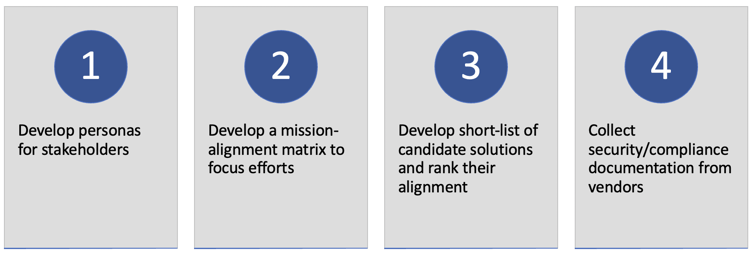
2. Field Test
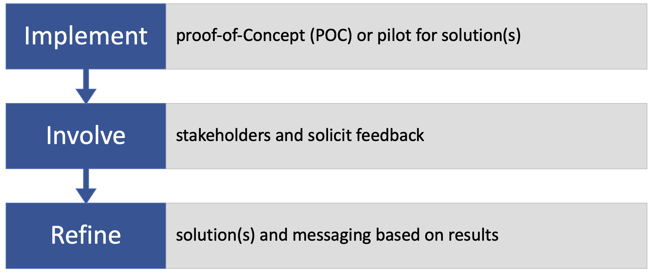
3. Document
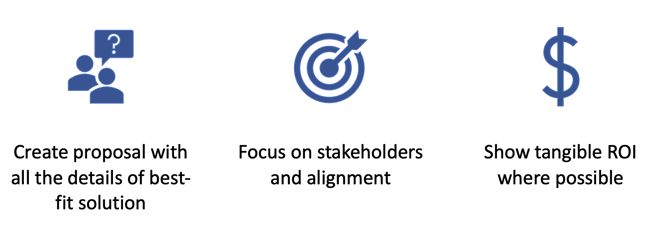
4. Present
 Lastly, it's time to ask...
Lastly, it's time to ask...
How do we execute and deliver success?
Once you've aligned about mission overlaps, how records management supports that, and have successfully messaged your business case, it's important to work together and continue communicating as you invest in and implement new RM strategies and solutions so all can succeed and reap the rewards together. Again...
1. Partnership
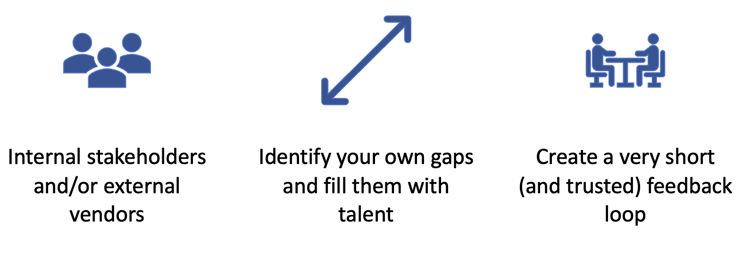 2. Storytelling (communicating with stakeholders' goals in mind)
2. Storytelling (communicating with stakeholders' goals in mind)
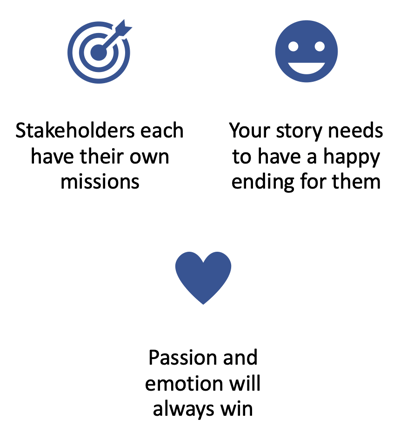
Conclusion
To sum, investment into records management can benefit everyone in an organization. To get a seat at the decision-makers' table, identify who is sitting there and what their mission and objectives are. By stepping into their shoes, you can then communicate how records management can help support their missions and alleviate some of their pain points.
Crafting this business case should be done with proper research, testing, documentation, and presentation. Once all has been communicated (and you've hopefully got the go-ahead!), stay connected through partnership and communication with your fellow departments, rather than disconnecting into silos. This ensures all stay on the same page, can have a say in RM projects and reap the benefits of time and investment into records management together!
To see the full presentation slides, download them for free below. Want to read more? The Collabware Blog is full of valuable and educative articles on records management! Need further support? Contact us, our services team has information governance experts at the ready. At lastly, check out our cloud solution, Collabspace, for end-to-end automated and compliant records management to benefit your entire organization.


